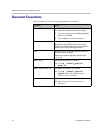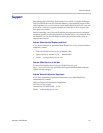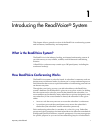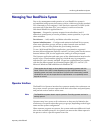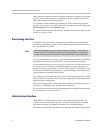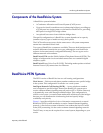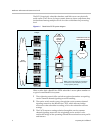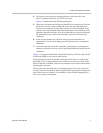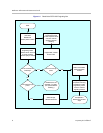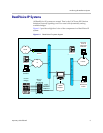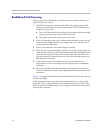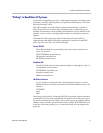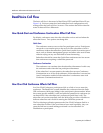
Introducing the ReadiVoice
®
System
Proprietary & Confidential 5
Components of the ReadiVoice System
A ReadiVoice system includes:
• A Conference Allocation and Control System (CACS) server.
• Up to twelve InnoVox media servers (conferencing bridges), providing up
to 5,760 ports in a single system, or one InnoVox media server, providing
4032 ports in a single 13U bridge cabinet.
• An optional boot server from which the bridges boot.
The specific configuration of a ReadiVoice system depends on its capacity
(number of ports), type of media server(s), and options.
The CACS and boot server may be the same server. All system components
mount into a standard 19-inch rack.
Two types of ReadiVoice systems are available. There are both hardware and
software differences between the two types, although the core ReadiVoice
software is the same (merely configured differently). The two types are for
different network environments:
ReadiVoice-PSTN uses the Public Switched Telephone Network (PSTN). The
bridge or bridges make circuit-switched connections over standard digital
telephony spans.
ReadiVoice-IP uses Voice Over IP (VOIP). The bridge makes packet-switched
Internet Protocol (IP) connections over Ethernet.
ReadiVoice-PSTN Systems
The PSTN version of ReadiVoice has two call routing configurations:
Fixed Access — Each access telephone number terminates on a specific bridge
in the system. This configuration is called a non-routed system.
Intelligent Network Call Routing (INCR) — Access telephone numbers
aren’t assigned to specific bridges. Instead, the ReadiVoice system uses a
carrier common channel signaling network (such as SS7 or Tollfree Gateway)
to dynamically route calls among available bridges. This configuration is
called a routed system. A routed system makes more efficient use of the bridges
because you can distribute the conferencing load and specify bridge
availability and priority.
Figure 1-1 provides a high-level view of the major components in a routed
ReadiVoice-PSTN system attached to a carrier common channel signaling
network. A fixed access system is identical, but without the Service Control
Point (SCP) connecting it to the carrier common channel signaling network.
The SCP may or may not be required for a routed system, depending on your
carrier.




